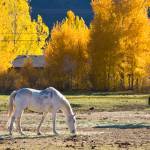Rotational Grazing for Horse Pastures

If you have other animals besides horses on your property, it may be a good idea to rotate these species onto your fields from time to time. Sheep and cattle will graze the areas that are avoided by horses. Sheep will tackle most weeds found in horse paddocks, and although neither cattle nor horses will eat pasture plants around their own droppings, they will graze around each other’s droppings.
Horses graze with their teeth; that is, they bite off the grass. Cattle tear the grass off with their tongues. Therefore, horses can graze close to the ground, whereas cattle need longer grass. Because of this, it is preferable to graze cattle in front of horses in a cattle–horse rotation. If horses are grazed first, however, the cattle will eat down long grass.
Alternating cattle or sheep with horses is also a worm-prevention strategy because, with one exception, the intestinal parasites of horses cannot survive in cattle or sheep. In larger paddocks, it is probably more practical to graze the horses with the sheep or cattle, though the horses may cause a problem by chasing the other livestock. Horses will occasionally attack calves, lambs, or sheep. Conversely, some horses will allow calves to chew their tails.
If there are only horses on the property, having several small paddocks rather than one large field will allow for paddock rotation, which will improve pasture growth and assist with parasite control.








